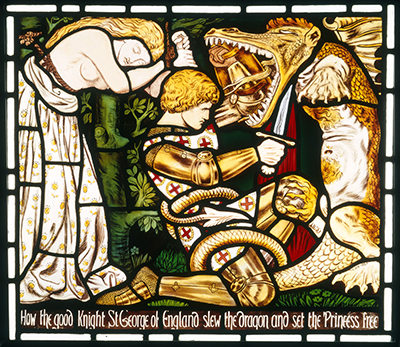 Buy Art Prints Now
Buy Art Prints Nowfrom Amazon
* As an Amazon Associate, and partner with Google Adsense and Ezoic, I earn from qualifying purchases.
The production of stained glass windows was a collaborative process that made use of the skills of the key figures in Morris, Marshall, Faulkner & Co. William Morris, plus colleague Philip Webb would predominantly work on the backgrounds of these pieces.
This highly skilled group were always seeking to determine who was best at what and would then arrange their commissions accordingly. Morris was respected for his knowledge of colour and would often make decisions around the overall colour balances of these items. Edward Burne-Jones, by contrast, was clearly the best at executing the final cut of glass and laying them out together in accordance with the original designs and would therefore be responsible for that. This group chose to portray their subjects within stained glass in a natural, human style which was in keeping with the generic style of the Pre-Raphaelite movement.
William Morris himself was famous for promoting the more traditional methods of art and to avoid the over-industrialisation of products within the UK. Stained glass windows were a fine example of this, where quality and care was key, nothing could be rushed. The beautiful that this group of artists put together spread across all of their careers, with the role of identifying who did precisely what in each one proving tricky in many cases. We only really know the normal roles that they would serve in this medium, and perhaps work out through other related information more on each one individually, such as location and precise date.
Morris, Marshall, Faulkner & Co were particularly fortunate in that the early 1860s were full of new church constructions, all of which attempted to hire the finest tradesmen in the land. Their reputation quickly grew and they also held good connections with a number of architects who would bring them into large projects in order to complete various elements of the interior. Their stained-glass designs provided a substantial part of their company's income over several decades and also helped to regenerate interest in this medium, in part with the aid of the Arts and Crafts Movement. It may still be seen as somewhat of a niche topic globally, but the use of brightly coloured glass to create stunning scenes of beauty retains a great significance within British art, for sure.
The example that we have displayed here was titled Legend of St George and is actually credited to Dante Gabriel Rossetti in around 1862. There has been considerable efforts in recent years to protect and preserve this very British style of art and despite the fragility of this medium, there is still plenty to enjoy from all those involved in putting them together during this period. Most have been taken from their original installations in order to protect them for future generations, whilst less valuable ones remain where they were intended to be. Many churches and cathedrals are still adorned with this beautiful form of art which continues to astound visitors as to its beauty on the rare occasions that the UK enjoys strong sunshine.




